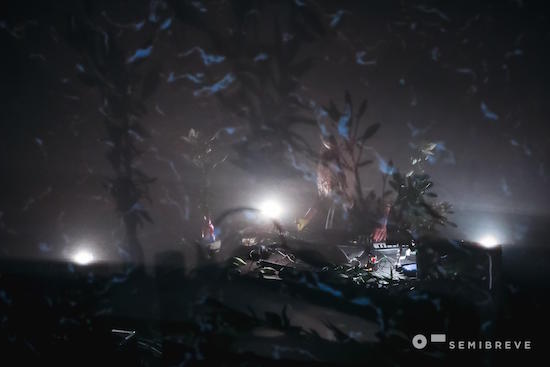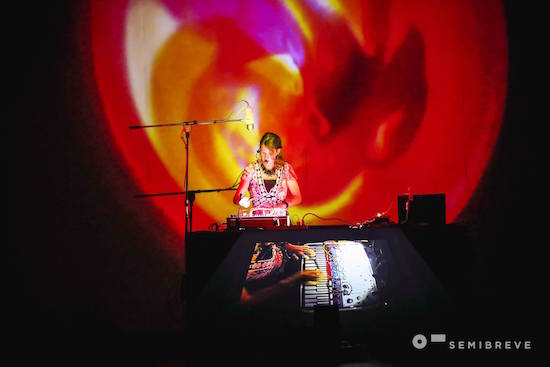Though not a concept-driven festival like Unsound or CTM, Semibreve’s relaxed atmosphere – which is Rapidly-Approaching-40 for ‘comfortable seating’ – diligent programming, beyond reasonable drinks prices and convivial city setting give it a contemplative aura conducive to relaxed enjoyment. Which basically means that you can be drinking pretty much all day, talk about interesting things with interesting people and not have to worry about watching anything shit.
Semibreve’s success is down to a few factors. First, the town of Braga is a joy, with the main venue Theatro Circo one of the most eye-poppingly oppulent arguments for arts funding I’ve ever seen. Second, the line-up consistently manages to be educational without being boring and banging without being boorish. Also its occurrence in October – right at the tail end of the festival season – means that it’s a festival you can arrive with mild shellshock and the thousand yard stare of a Vietnam veteran knowing that no-one’s going to deliver the musical equivalent of throwing a live cat at you.
But that doesn’t mean Semibreve doesn’t hold any surprises. Despite a modest line-up and just two evening venues Semibreve packs in a good amount of variety. But what’s interesting about this small line up, and the relatively limited pool it picks from – modern, progressive electronic music – is that it positions the listener to focus more intently on what’s in front of them and to look for connections between it all – and because of this sharp focus, to find them.
Kara-Lis Coverdale can’t be seen. From behind a sheet we can see the twinkling of electronic instruments, a tall figure and a large pot plant. Onto the sheet Marcel Weber – aka MFO – is projecting an ever-pustulating field of vivid purples mixed against lightning flashes of static. The combination of Coverdale’s glassy, pulsating music and the shifting corpus of the projections makes me think of some benevolent entity; a science-created synthiform incapable of harm or malice. It is un-ragged, composed as if rock music never happened. As if even thinking about whatever this is and good old rock’n’roll in the same thought is like comparing a nanobot-cloud to a wooden train set. Which perhaps it is.
Laurel Halo’s performance on the Saturday at local venue GNRation maps out similar contours, albeit with a focus on the dancefloor. There are no projections, but the effect of the music is nonetheless visual to the point of tactility. There’s a plasticity to the sound that resists the temptation toward distortion or any other common signifier of The Big Release and the effect is closer to being in a room surrounded by one of Andy Warhol’s floating pillow sculptures than it is anything more conventionally cathartic. It’s gorgeous as well, by the way: intoxicatingly alien and slippery. It doesn’t make me want to dance so much as stick my tongue out and see if I can taste the air. This movement toward more precise, Oculus Rift contours is visible throughout the weekend. In Oliver Coates’ choice of projection – a kind of endless, existentialist game of Doom played amid a tropical paradise – and in Nidia Minaj’s gleefully messy and riotously neonic splatter of beats and samples you sense an attempt to pull free from dull signifiers and force out a space in the detritus of the 21st Century. Although interestingly, only Klara-Lis Coverdale’s set is particularly hallucinogenic, the amorphous combination of visuals and sound creating a far less matter-of-fact surface tension than Halo’s more brittle constructs.

All this isn’t to say that Semibreve is without dumb thrill. The more traditionally cathartic sensations of frenzied distortion, jackhammer beats and suffocating noise are well represented. And Tyondai Braxton’s set on the Sunday is particularly violent and unpredictable. Matching unsettled rhythmic batterings against hissing hydro-electronics and bursts of furious noise, it seems as if Braxton is breaking rules as fast as he can come up with them and the result is a perfect balance of the playful and the vicious. It’s a goddam slalom. Paul Jebanesem and visual artist Tarik Barri’s collaboration contains a similar balance between overwhelming sensation and surprise, with Barri’s precise, strobing visuals hissing through the gaps between Jebanasam’s dense blocks of anti-matter. Along with Klara-Lis Coverdale’s set it’s one of the few that could be categorised as genuinely psychedelic from throughout the weekend.
Jonathan Saldanha’s performance in the basement of Theatro Circo is another matter entirely though. Billed as a performance of his score to Raz Manai’s avant-garde science fiction film Tunnel Vision, Saldana chooses to subvert the concept of the AV show by taking the V away from the A and sitting the audience in near complete darkness. The reasons for this minimalistic approach soon become apparent. Sat in a pitch black room, Saldanha’s mastery of how to manipulate acoustic space comes to resemble something approximating necromancy. Instead of watching a film about tunnels – because believe me, tunnels are what Tunnel Vision is all about – Saldanha dumps us inside a particularly terrifying one and we are left to fend for ourselves. It’s confusing, exhilarating and more than a bit unnerving. It also leaves me pondering why there are so few times that music utilises sound that actually feels like it’s getting closer to you, a sensation that happens several times during the show. A sound creeps onto the edge of your mind and then slowly hovers into focus – meaning that for a tantalising second you don’t know if you’re imagining it – until it’s suddenly EXTREMELY CLOSE and breathing into your face like an angry animal. It’s petrifyingly effective, to the extent that the only comparable piece of art I’ve seen recently is director Ciro Guerra’s Embrace Of The Serpent, with its conjuring of atavistic fears and long-held terrors seeming to speak directly to dormant parts of the brain. Saldanha’s is the performance that most effectively exploits the space surrounding the audience and in doing so pushes its way into moments of exhilarating beauty and almost sculptural density. It is the highlight of the festival and delivers on everything that Semibreve, with its dedication to forward-thinking art and challenging methods of expression, promises.


